Temperature-Dependent Olive Pomace Extraction for Obtaining Bioactive Compounds Preventing the Death of Murine Cortical Neurons
Abstract
1. Introduction
2. Results and Discussion
2.1. Effects of Extraction Temperature on Total Polyphenol Contents and Antiradical Power
2.2. Further Treatment at 180 °C of the Extracts
2.3. HPLC Analysis
3. Materials and Methods
3.1. Raw Materials and Chemicals
3.2. High-Pressure and Temperature Extraction (HPTE)
3.3. Total Polyphenols and Antiradical Activity Analysis
3.4. HPLC-DAD Analysis
3.5. Total Solids and Bulk Density
3.6. Cell Culture
3.7. Cell Viability Assay
3.8. [Ca2+]i Assay
3.9. Statistical Analysis
4. Conclusions
Author Contributions
Funding
Institutional Review Board Statement
Informed Consent Statement
Data Availability Statement
Acknowledgments
Conflicts of Interest
References
- Pour, F.H.; Makkawi, Y.T. A Review of Post-Consumption Food Waste Management and Its Potentials for Biofuel Production. Energy Rep. 2021, 7, 7759–7784. [Google Scholar] [CrossRef]
- Amicarelli, V.; Bux, C. Food Waste Measurement toward a Fair, Healthy and Environmental-Friendly Food System: A Critical Review. Br. Food J. 2020, 123, 2907–2935. [Google Scholar] [CrossRef]
- Conrad, Z.; Blackstone, N.T. Identifying the Links between Consumer Food Waste, Nutrition, and Environmental Sustainability: A Narrative Review. Nutr. Rev. 2021, 79, 301–314. [Google Scholar] [CrossRef] [PubMed]
- Manzanares, P.; Ballesteros, I.; Negro, M.J.; González, A.; Oliva, J.M.; Ballesteros, M. Processing of Extracted Olive Oil Pomace Residue by Hydrothermal or Dilute Acid Pretreatment and Enzymatic Hydrolysis in a Biorefinery Context. Renew. Energy 2020, 145, 1235–1245. [Google Scholar] [CrossRef]
- Cecchi, L.; Khatib, M.; Bellumori, M.; Civa, V.; Domizio, P.; Innocenti, M.; Balli, D.; Mulinacci, N. Industrial Drying for Agrifood By-Products Re-Use: Cases Studies on Pomegranate Peel (Punica Granatum L.) and Stoned Olive Pomace (Pâtè, Olea Europaea L.). Food Chem. 2023, 403, 134338. [Google Scholar] [CrossRef]
- Souilem, S.; El-Abbassi, A.; Kiai, H.; Hafidi, A.; Sayadi, S.; Galanakis, C.M. Olive Oil Production Sector: Environmental Effects and Sustainability Challenges. In Olive Mill Waste Recent Advances for Sustainable Managment, 1st ed.; Galanakis, C.M., Ed.; Elsevier: Oxford, UK, 2017; pp. 1–28. [Google Scholar] [CrossRef]
- Sánchez-Arévalo, C.M.; Pérez García-Serrano, A.; Vincent-Vela, M.C.; Álvarez-Blanco, S. Combining Ultrafiltration and Nanofiltration to Obtain a Concentrated Extract of Purified Polyphenols from Wet Olive Pomace. Membranes 2023, 13, 119. [Google Scholar] [CrossRef] [PubMed]
- Marchetti, C.; Clericuzio, M.; Borghesi, B.; Cornara, L.; Ribulla, S.; Gosetti, F.; Marengo, E.; Burlando, B. Oleuropein-Enriched Olive Leaf Extract Affects Calcium Dynamics and Impairs Viability of Malignant Mesothelioma Cells. eCAM 2015, 2015, 1–9. [Google Scholar] [CrossRef]
- Radić, K.; Vrček, V.; Pavičić, I.; Čepo, D.V. Cellular Antioxidant Activity of Olive Pomace Extracts: Impact of Gastrointestinal Digestion and Cyclodextrin Encapsulation. Molecules 2020, 25, 5027. [Google Scholar] [CrossRef]
- Romani, A.; Ieri, F.; Urciuoli, S.; Noce, A.; Marrone, G.; Nediani, C.; Bernini, R. Health Effects of Phenolic Compounds Found in Extra-Virgin Olive Oil, By-Products, and Leaf of Olea Europaea L. Nutrients 2019, 11, 1776. [Google Scholar] [CrossRef]
- Yazawa, K.; Kihara, T.; Shen, H.; Shimmyo, Y.; Niidome, T.; Sugimoto, H. Distinct Mechanisms Underlie Distinct Polyphenol-induced Neuroprotection. FEBS Lett. 2006, 580, 6623–6628. [Google Scholar] [CrossRef] [PubMed]
- Aliakbarian, B.; Palmieri, D.; Casazza, A.A.; Palombo, D.; Perego, P. Antioxidant Activity and Biological Evaluation of Olive Pomace Extract. Nat. Prod. Res. 2012, 26, 2280–2290. [Google Scholar] [CrossRef] [PubMed]
- Ju, Z.Y.; Howard, L.R. Effects of Solvent and Temperature on Pressurized Liquid Extraction of Anthocyanins and Total Phenolics from Dried Red Grape Skin. J. Agric. Food Chem. 2003, 51, 5207–5213. [Google Scholar] [CrossRef]
- Paini, M.; Casazza, A.A.; Aliakbarian, B.; Perego, P.; Binello, A.; Cravotto, G. Influence of Ethanol/Water Ratio in Ultrasound and High-pressure/High-temperature Phenolic Compound Extraction from Agri-food Waste. Int. J. Food Sci. Technol. 2016, 51, 349–358. [Google Scholar] [CrossRef]
- Averna, M.; Casazza, A.A.; Martines, A.; Pedrazzi, M.; Franchi, A.; De Tullio, R.; Perego, P.; Melloni, E. Cell Protection from Ca 2+-Overloading by Bioactive Molecules Extracted from Olive Pomace. Nat. Prod. Res. 2019, 33, 1449–1455. [Google Scholar] [CrossRef] [PubMed]
- Franchi, A.; Pedrazzi, M.; Casazza, A.A.; Millo, E.; Damonte, G.; Salis, A.; Liessi, N.; Onofri, F.; Marte, A.; Casagrande, S.; et al. A Bioactive Olive Pomace Extract Prevents the Death of Murine Cortical Neurons Triggered by NMDAR Over-Activation. Molecules 2020, 25, 4385. [Google Scholar] [CrossRef] [PubMed]
- Companys-Alemany, J.; Turcu, A.L.; Schneider, M.; Müller, C.E.; Vázquez, S.; Griñán-Ferré, C.; Pallàs, M. NMDA Receptor Antagonists Reduce Amyloid-β Deposition by Modulating Calpain-1 Signaling and Autophagy, Rescuing Cognitive Impairment in 5XFAD Mice. CMLS 2022, 79, 408. [Google Scholar] [CrossRef] [PubMed]
- Averna, M.; Pellegrini, M.; Cervetto, C.; Pedrazzi, M.; Bavestrello, M.; De Tullio, R.; Salamino, F.; Pontremoli, S.; Melloni, E. Physiological Roles of Calpain 1 Associated to Multiprotein NMDA Receptor Complex. PLoS ONE 2015, 10, e0139750. [Google Scholar] [CrossRef]
- Aliakbarian, B.; Casazza, A.A.; Perego, P. Valorization of Olive Oil Solid Waste Using High Pressure-High Temperature Reactor. Food Chem. 2011, 128, 704–710. [Google Scholar] [CrossRef]
- Richter, B.E.; Jones, B.A.; Ezzell, J.L.; Porter, N.L.; Avdalovic, N.; Pohl, C. Accelerated Solvent Extraction: A Technique for Sample Preparation. Anal. Chem. 1996, 68, 1033–1039. [Google Scholar] [CrossRef]
- Gavahian, M.; Mathad, G.N.; Pandiselvam, R.; Lin, J.; Sun, D.-W. Emerging Technologies to Obtain Pectin from Food Processing By-Products: A Strategy for Enhancing Resource Efficiency. Trends Food Sci. Technol. 2021, 115, 42–54. [Google Scholar] [CrossRef]
- Tapia-Quirós, P.; Montenegro-Landívar, M.F.; Reig, M.; Vecino, X.; Alvarino, T.; Cortina, J.L.; Saurina, J.; Granados, M. Olive Mill and Winery Wastes as Viable Sources of Bioactive Compounds: A Study on Polyphenols Recovery. Antioxidants 2020, 9, 1–15. [Google Scholar] [CrossRef] [PubMed]
- Belghith, Y.; Kallel, I.; Rosa, M.; Stathopoulos, P.; Skaltsounis, L.A.; Allouche, N.; Chemat, F.; Tomao, V. Intensification of Biophenols Extraction Yield from Olive Pomace Using Innovative Green Technologies. Biomolecules 2023, 13, 65. [Google Scholar] [CrossRef] [PubMed]
- Cacace, J.E.; Mazza, M. Mass transfer process during extraction of phenolic compounds from milled berries. J. Food Eng. 2003, 59, 379–389. [Google Scholar] [CrossRef]
- Putnik, P.; Barba, F.J.; Španić, I.; Zorić, Z.; Dragović-Uzelac, V.; Bursać Kovačević, D. Green Extraction Approach for the Recovery of Polyphenols from Croatian Olive Leaves (Olea Europea). Food Bioprod. 2017, 106, 19–28. [Google Scholar] [CrossRef]
- Jiang, Z.; Han, Z.; Wen, M.; Ho, C.T.; Wu, Y.; Wang, Y.; Xu, N.; Xie, Z.; Zhang, J.; Zhang, L.; et al. Comprehensive Comparison on the Chemical Metabolites and Taste Evaluation of Tea after Roasting Using Untargeted and Pseudotargeted Metabolomics. Food Sci. Hum. Wellness 2022, 11, 606–617. [Google Scholar] [CrossRef]
- Liao, J.J.; Latif, N.H.A.; Trache, D.; Brosse, N.; Hussin, M.H. Current Advancement on the Isolation, Characterization and Application of Lignin. Int. J. Biol. Macromol. 2020, 162, 985–1024. [Google Scholar] [CrossRef]
- Liu, J.; Sandahl, M.; Sjoberg, P.J.R.; Turner, C. Pressurised hot water extraction in continuous flow mode for thermolabile compounds: Extraction of polyphenols in red onions. Anal. Bioanal. Chem. 2014, 406, 441–445. [Google Scholar] [CrossRef]
- Le Bourvellec, C.; Renard, C.M.G.C. Interactions between Polyphenols and Macromolecules: Quantification Methods and Mechanisms. Crit. Rev. Food Sci. Nutr. 2012, 52, 213–248. [Google Scholar] [CrossRef]
- He, J.; Huang, C.; Lai, C.; Li, M.; Pu, Y.; Ragauskas, A.J.; Yong, Q. The effect of lignin degradation products on the generation of pseudo-lignin during dilute acid pretreatment. Ind. Crop Prod. 2020, 146, 112205. [Google Scholar] [CrossRef]
- Re, R.; Pellegrini, N.; Proteggente, A.; Pannala, A.; Yang, M.; Rice-Evans, C. Antioxidant Activity Applying an Improved ABTS Radical Cation Decolorization Assay. Free Radic. Biol. Med. 1999, 26, 1231–1237. [Google Scholar] [CrossRef]
- Chung, H.-S.; Chung, S.-K.; Youn, K.-S. Effects Of Roasting Temperature And Time On Bulk Density, Soluble Solids, Browning Index And Phenolic Compounds Of Corn Kernels. J. Food Process Preserv. 2011, 35, 832–839. [Google Scholar] [CrossRef]
- Repetto, G.; Del Peso, A.; Zurita, J.L. Neutral red uptake assay for the estimation of cell viability/cytotoxicity. Nat. Protoc. 2008, 3, 1125–1131. [Google Scholar] [CrossRef] [PubMed]
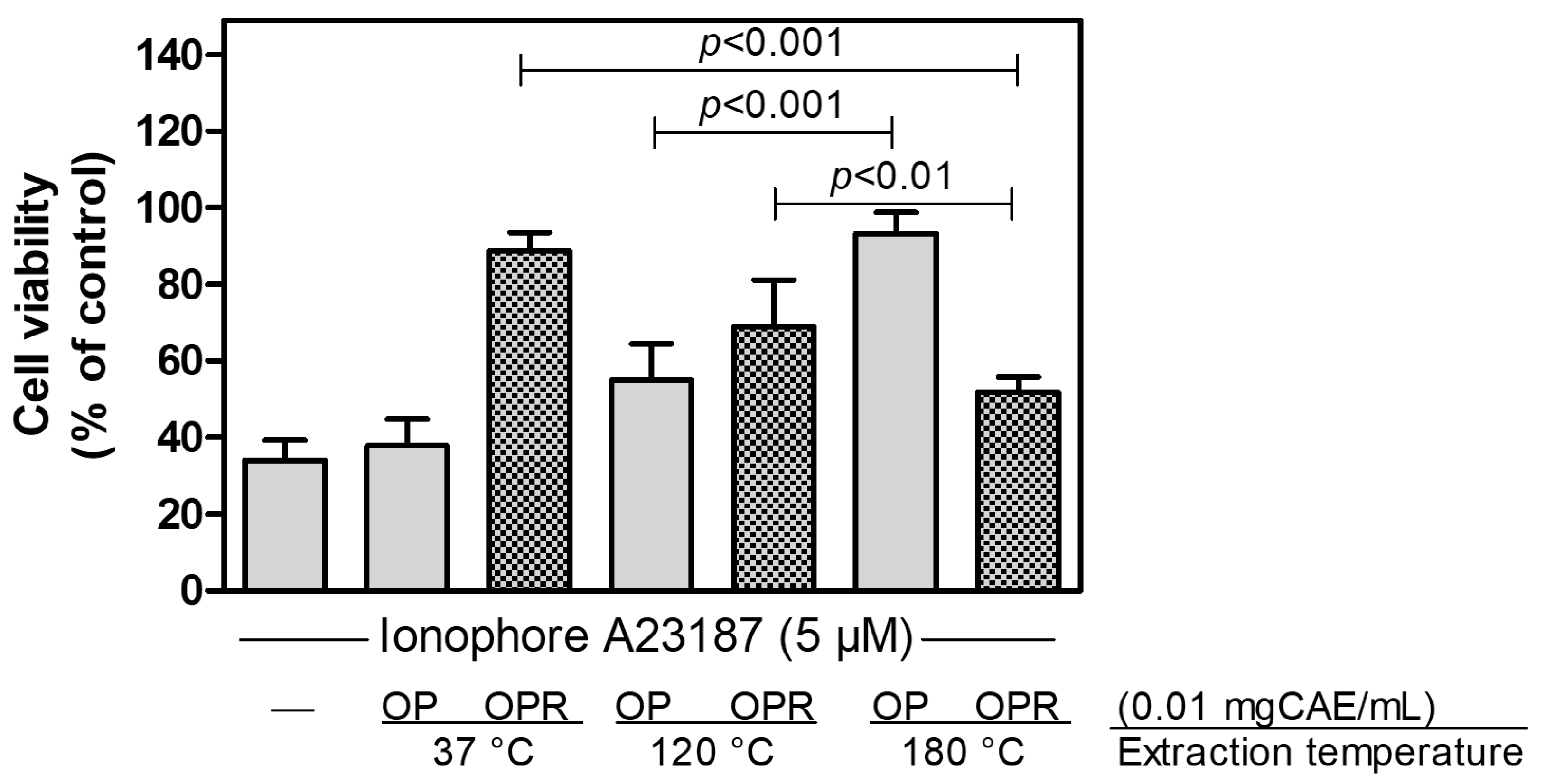
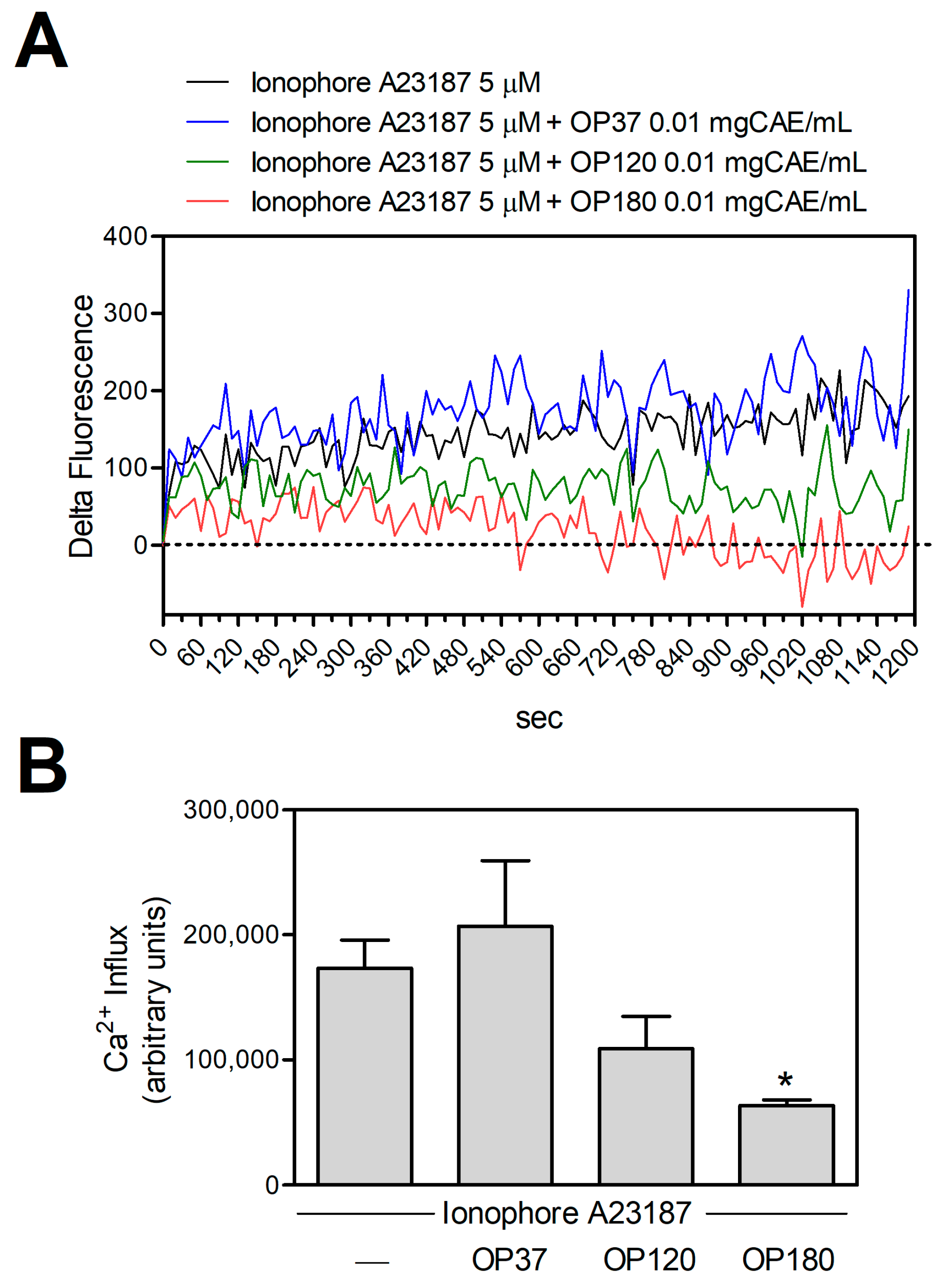
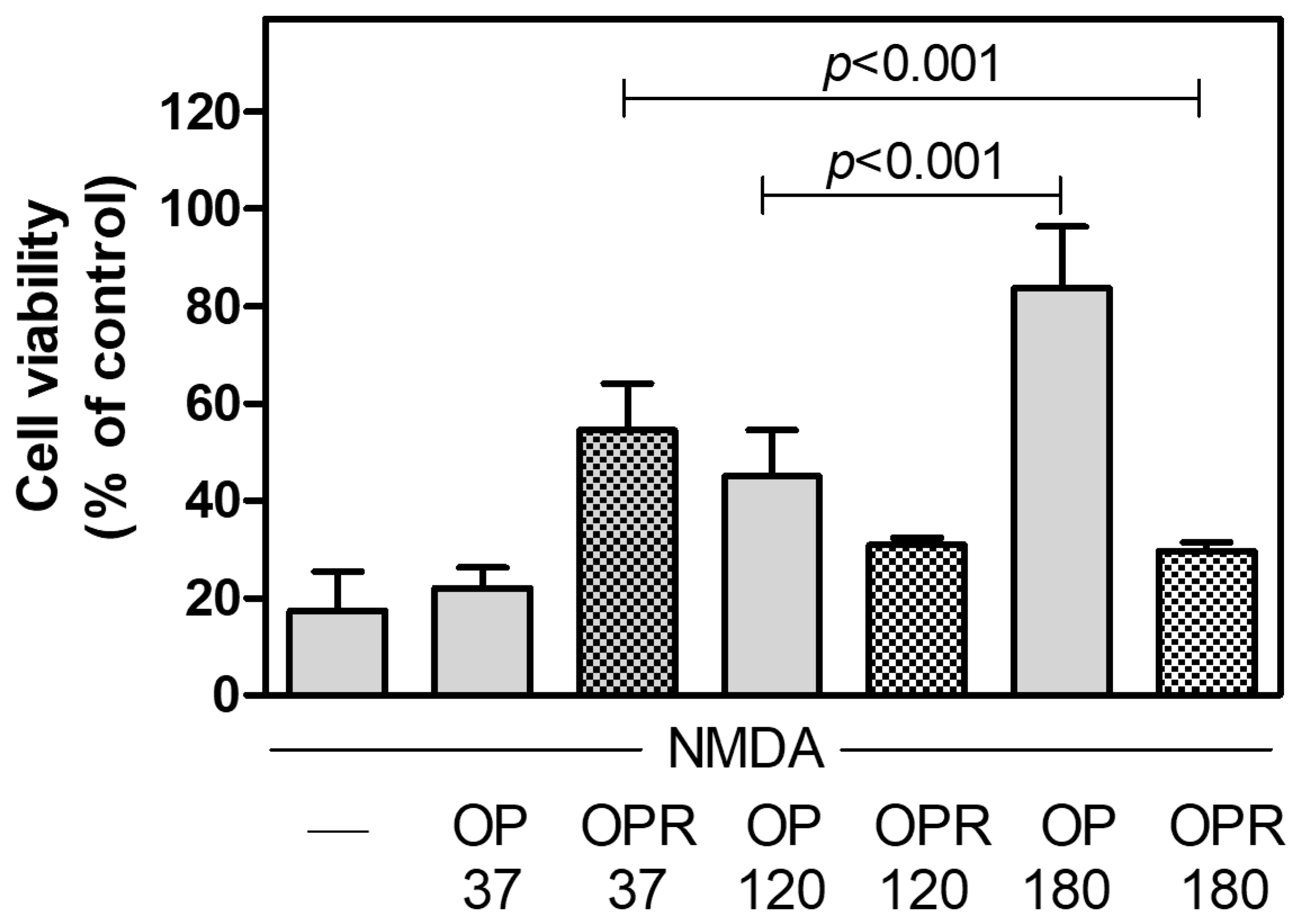
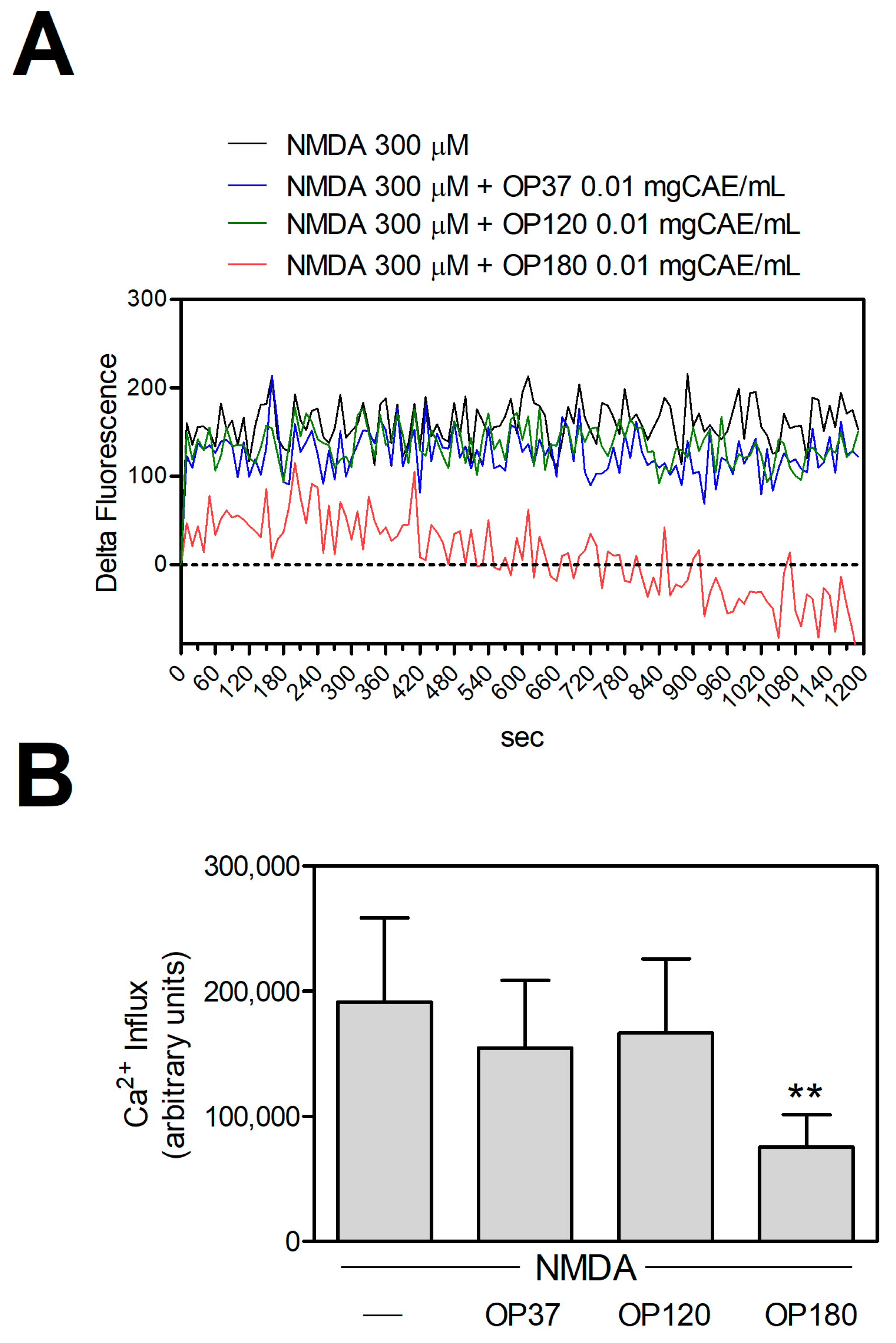
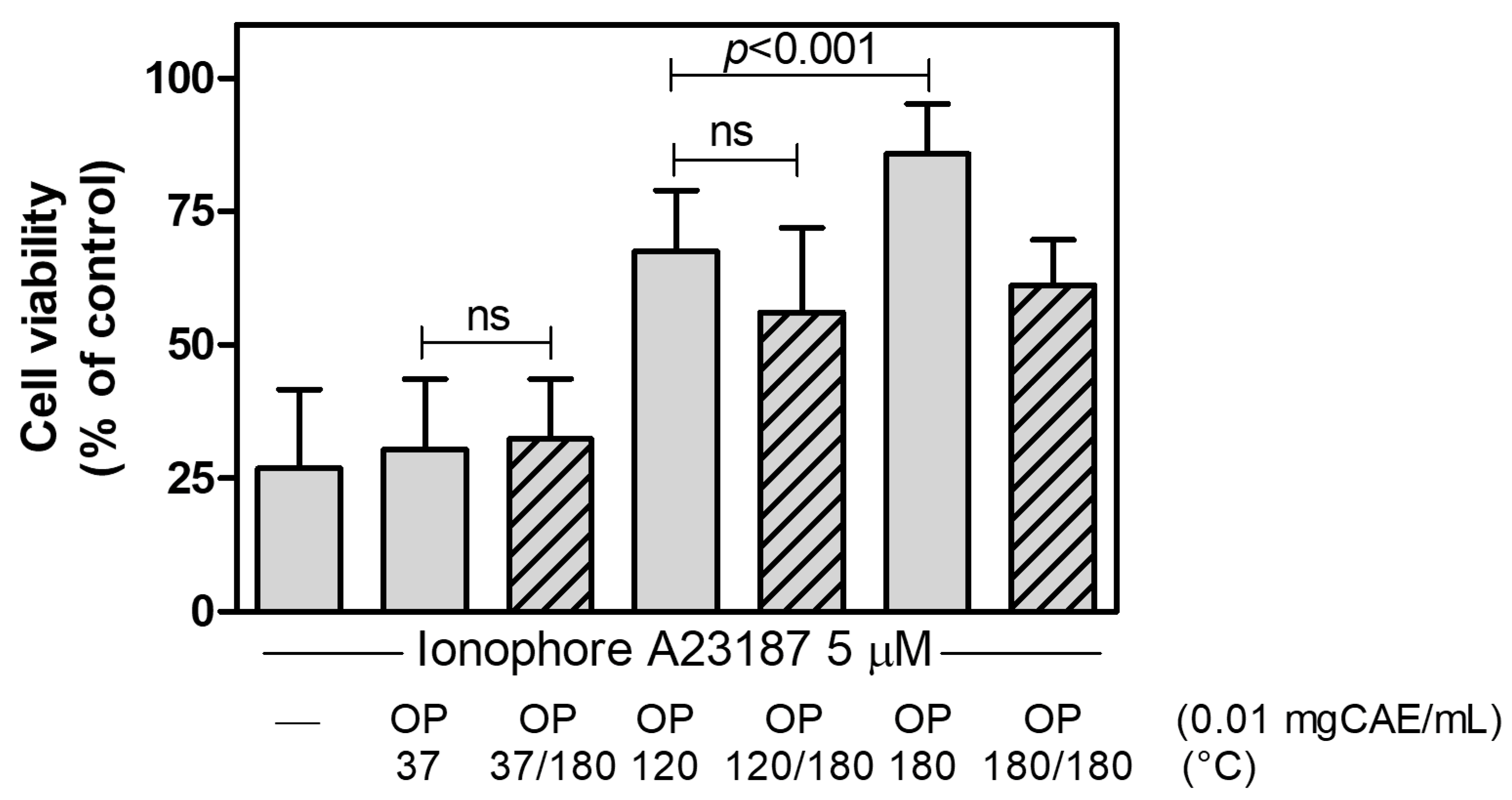
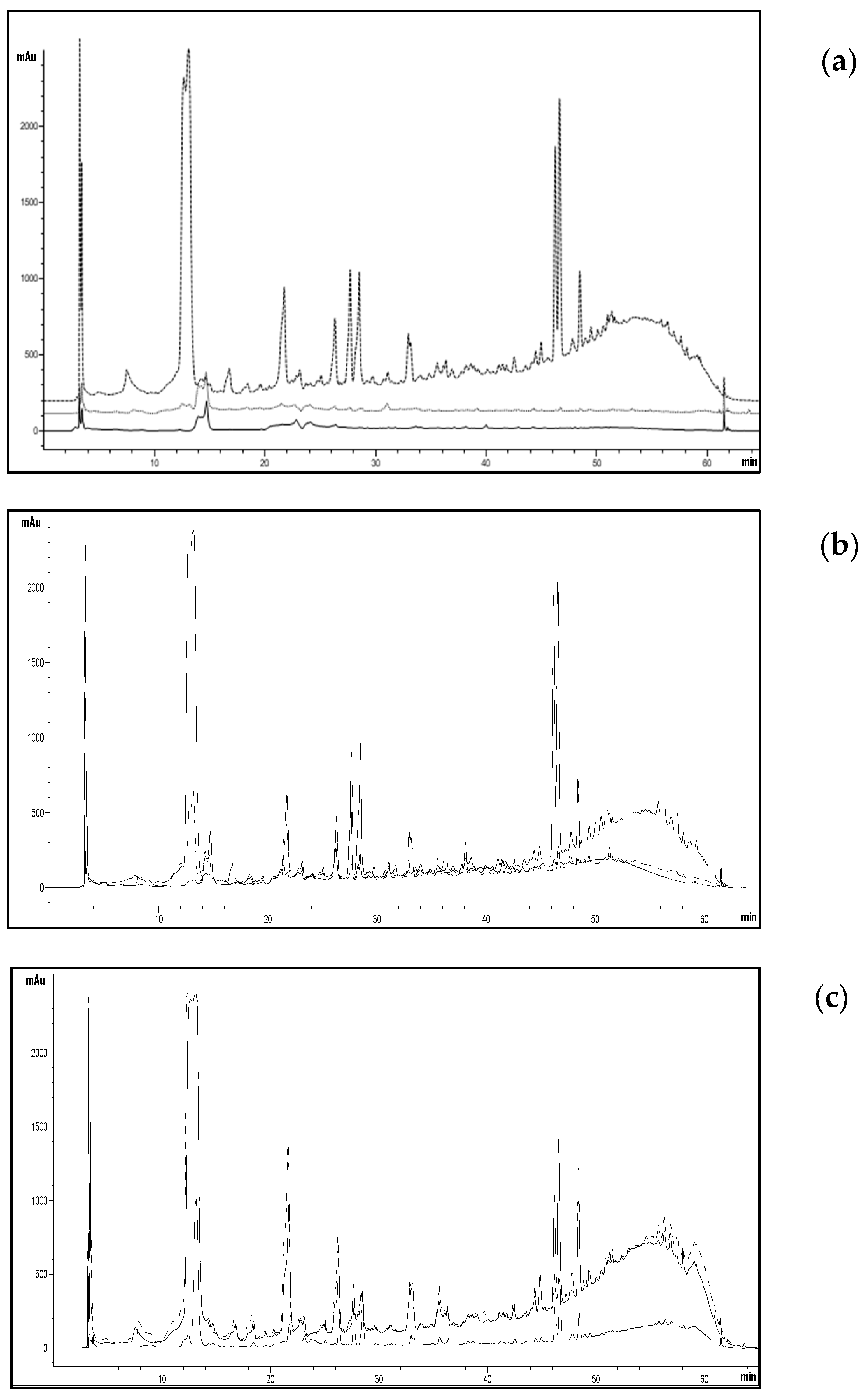
| Extraction Temperature (°C) | TPC (mgCAE/mLextract) | TPY (mgCAE/gOP) | ARP (mgTE/mLextract) | Extract Total Solids (mg/mL) | Residue Bulk Density (g/cm3) | |
|---|---|---|---|---|---|---|
| OP37 | 37 | 0.58 ± 0.01 | 5.80 ± 0.15 | 0.68 ± 0.05 | 5.48 ± 0.67 | 0.502 ± 0.018 |
| OP120 | 120 | 2.25 ± 0.22 | 25.22 ± 2.17 | 5.39 ± 0.05 | 11.53 ± 0.23 | 0.388 ± 0.018 |
| OP180 | 180 | 6.31 ± 0.09 | 63.13 ± 0.90 | 15.06 ± 0.06 | 30.88 ± 0.06 | 0.319 ± 0.013 |
| OPR37 | 180 | 5.98 ± 0.40 | 59.78 ± 4.00 | 9.43 ± 0.35 | 30.53 ± 1.07 | 0.239 ± 0.012 |
| OPR120 | 180 | 4.07 ± 0.13 | 40.74 ± 1.29 | 9.16 ± 0.07 | 30.22 ± 0.55 | 0.262 ± 0.029 |
| OPR180 | 180 | 3.42 ± 0.08 | 45.20 ± 0.84 | 4.63 ± 0.29 | 12.55 ± 0.49 | 0.232 ± 0.002 |
| TPC (mgCAE/mLextract) | ARP (mgTE/mLextract) | Extract Total Solids (mg/mL) | |
|---|---|---|---|
| OP37/180 | 0.92 ± 0.06 | 3.21 ± 0.36 | 12.55 ± 0.49 |
| OP120/180 | 3.00 ± 0.05 | 5.99 ± 0.42 | 2.90 ± 0.40 |
| OP180/180 | 5.48 ± 0.73 | 11.94 ± 0.32 | 8.15 ± 0.85 |
| Total Area280nm | 4-Hydroxy Benzoic Acid (mg/L) | Caffeic Acid (mg/L) | Oleuropein (mg/L) | |
|---|---|---|---|---|
| OP37 | 70,514 | 1.3 | 16.8 | 53.7 |
| OP120 | 312,870 | 16.8 | 32.1 | 1107.9 |
| OP180 | 1,070,876 | 32.2 | 41.3 | 897.4 |
| OPR37 | 915,217 | 28.2 | 48.8 | 1038.7 |
| OPR120 | 814,442 | 20.4 | 34.6 | 877.8 |
| OPR180 | 219,365 | 5.6 | 15.5 | 122.5 |
| OP37/180 | 104,862 | 16.8 | 17.3 | 54.0 |
| OP120/180 | 359,021 | 29.2 | 28.7 | 439.4 |
| OP180/180 | 1,159,472 | 44.4 | 17.6 | 571.5 |
Disclaimer/Publisher’s Note: The statements, opinions and data contained in all publications are solely those of the individual author(s) and contributor(s) and not of MDPI and/or the editor(s). MDPI and/or the editor(s) disclaim responsibility for any injury to people or property resulting from any ideas, methods, instructions or products referred to in the content. |
© 2024 by the authors. Licensee MDPI, Basel, Switzerland. This article is an open access article distributed under the terms and conditions of the Creative Commons Attribution (CC BY) license (https://creativecommons.org/licenses/by/4.0/).
Share and Cite
Casazza, A.A.; Capraro, M.; Pedrazzi, M.; D’Agostino, G.; Onofri, F.; Marte, A.; De Tullio, R.; Perego, P.; Averna, M. Temperature-Dependent Olive Pomace Extraction for Obtaining Bioactive Compounds Preventing the Death of Murine Cortical Neurons. Int. J. Mol. Sci. 2024, 25, 907. https://doi.org/10.3390/ijms25020907
Casazza AA, Capraro M, Pedrazzi M, D’Agostino G, Onofri F, Marte A, De Tullio R, Perego P, Averna M. Temperature-Dependent Olive Pomace Extraction for Obtaining Bioactive Compounds Preventing the Death of Murine Cortical Neurons. International Journal of Molecular Sciences. 2024; 25(2):907. https://doi.org/10.3390/ijms25020907
Chicago/Turabian StyleCasazza, Alessandro Alberto, Michela Capraro, Marco Pedrazzi, Giulia D’Agostino, Franco Onofri, Antonella Marte, Roberta De Tullio, Patrizia Perego, and Monica Averna. 2024. "Temperature-Dependent Olive Pomace Extraction for Obtaining Bioactive Compounds Preventing the Death of Murine Cortical Neurons" International Journal of Molecular Sciences 25, no. 2: 907. https://doi.org/10.3390/ijms25020907
APA StyleCasazza, A. A., Capraro, M., Pedrazzi, M., D’Agostino, G., Onofri, F., Marte, A., De Tullio, R., Perego, P., & Averna, M. (2024). Temperature-Dependent Olive Pomace Extraction for Obtaining Bioactive Compounds Preventing the Death of Murine Cortical Neurons. International Journal of Molecular Sciences, 25(2), 907. https://doi.org/10.3390/ijms25020907








